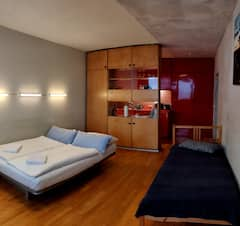Located at Reichstagufer 17, 10117 Berlin, the Tränenpalast, Palace of Tears, is a truly moving museum that you should visit. The Palace of Tears is directly to the north of Friedrichstraße station and is a short walk from other important sights in Mitte which include the Reichstag, Brandenburger Tor, Unter den Linden and Museum Island. The Tränenpalast is open from Tuesday – Friday from 9.00 am – 7.00 pm and on Saturday – Sunday from 10.00 am – 6.00 pm. Entry is free. The location and actual museum was the main departure point for travellers from the former East Germany to West Germany. During the Cold War, more travellers crossed this border control than they did Checkpoint Charlie. Surprisingly, the Tränenpalast is not as well known as a site, so I am glad to share some insight on it with you.
Tearful farewells and difficult goodbyes

Today, the museum within this historic building symbolises and represents the diverse experiences that people faced in this location. East Germans had to bid a tearful farewell to their family and friends who were returning or leaving for the West, whilst not knowing whether they could join them later or ever see them again. East Germans were not permitted to travel to West Berlin unless under rare exception. The Tränenpalast building was constructed in 1962 and was part of the Friedrichstraße station and served the German Democratic Republic dictatorship until 1990. The name, “Palace of Tears” was because of its surprisingly elegant design for an East German building and because it was a place for understandably difficult goodbyes.
Intimidating questioning in passport control booths

A broad spectrum of personal emotions and experiences were felt by so many people in this establishment. The site had separate checkpoints for West Berliners, West Germans, foreigners, diplomats, transit travellers and East Germans. Many original items are on display within the museum whilst others, such as the passport control booths, have been re-created. The replica passport control booths are complete with mirrors and raised floors for the officials. Visitors and family members travelling together had to individually enter one of these passport control booths and hope that the door opened again on the other side for them to leave for the West, otherwise they faced invasive and intimidating questioning.
You will feel shivers down your spine

There are a number of photographs and a wide range of historical videos available for viewing in the museum. This allows you to truly understand personal stories of people who were trying to leave the East. Almost all items within the museum are described in both German and English and if you stop to read them and think for a moment about how the individuals involved were feeling, it will send a shiver down your spine.
The contents in this museum are the most intimate and personal consequences of the Cold War; it brings to life the separation of families, couples, parents, children, siblings, grandchildren and friends. It is a haunting place of farewells. There is a suitcase which includes a small porcelain ballerina that a woman, who was a child, smuggled with her when her mother and her fled East Germany. There are also letters from a teenage couple that were separated by the border. There is no better place to be reminded of the personal impact of big politics than this museum.
You might be interested in these Airbnbs!
Remind or enlighten yourself by visiting the Tränenpalast
The museum is small but it packs in the timeline from the segregation of East and West Germany up until the time that the Berlin Wall fell. Its small size allows you to easily traverse through it in about an hour to two hours whilst actually absorbing all of its contents. There are so many incredible museums that are free to the public in Berlin and credit must be given to this city for being so open to assist visitors to understand the trials and tribulations experienced over decades. The Tränenpalast does an exceptional role in recalling the events that occurred in this establishment that impacted the ordinary lives of German citizens. It is well worth visiting if you want to remind or enlighten yourself.
History
Get Trip101 in your inbox
Unsubscribe in one click. See our Privacy Policy for more information on how we use your data
























Create an account to